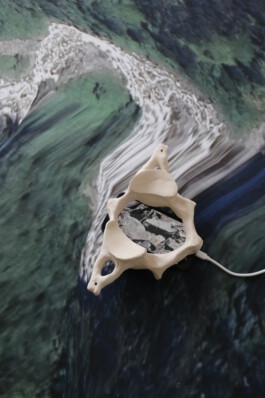cuando vuelves a tu tierra
multimedia installation, 2023 ceramic, clay, textile, smartphonescreen, photography
at galeria no_lugar Quito, Ecuador

As a child, Salcedo Horn and her father often visited his homeland via Google Earth.
She knows the village, the mountains and valleys mostly from above, from the satellites perspective.
Cuando vuelves a tu tierra explores her experience of being physically reunited with the homeland of her father in the Andean mountains of Ecuador. In 2023 she travelled to El Quinche, Ecuador and collected soil and clay from the actual places she mostly knew from the screen and family stories. The clay was recovered from adobe bricks of the house of her grandmother, from family farmland and on hikes through the mountains surrounding the village. She formed hands out of it, which hold and extract at the same time.
The work searches the link between soil, territory and memory and creates a dialogue between the physical and the virtual, the past and the present, the intimate and the public. Cuando vuelves a tu tierra reflects on how to relate to the land, the landscape, our memories and emotions when we return to the earth.



When do you return to your land
Raw mud, google earth pictures, archive pictures, 2023
Marie Salcedo Horn's residency process involves the emotions of returning to her country.Of being reunited with her family, her home, her traditions, her landscapes, her land. It is a return to her memories updated by time, like revisiting history from the present.
During the residency process Salcedo Horn looked for clay from various private and public places, each of them full of memories, anecdotes and emotions. The mud, the earth, are containers of stories. Here is recorded the entire history of humanity and the planet, the memories, the wars, the struggles, the tears, the love, the blood, the landscape, the pollution. Everything, in one way or another, is recorded in every grain of earth.
Salcedo Horn recovers the mud from the adobe bricks left over from an old house she finds in Guápulo, or from the old house of her grandmother who lives in El Quinche. She also finds mud on hikes through mountains she walked in her childhood and to which she returns now, or she is given a bit of soil from a lemon tree that was saved from dying.
The earth contains the history of humanity.
The artist takes each one of these muds and makes a series of uncooked hands. The mud is raw, alive, latent, just like the memory that each one of these places contains, memories that are translated into the sensations that the artist experiences when she contemplates and relates to the landscape, the people and the place she visits. Salcedo Horn puts in dialogue the hands, which are the record of these sensations brought by the mud, the territory, the landscape, her memories, with photos of the places she visited taken from google earth and photos from her personal archive.
Technology can be a means to access information, images and data about the world, as well as to question the modes of representation, perception and communication it generates. Technology can also be a way to reflect on the social, environmental and cultural impacts it produces. Territory can also be a way to understand the relationships between people, nature and culture.
Salcedo Horn explores the link between clay, territory and memory through her ceramic sculptures and digital images, and creates a dialogue between the physical and the virtual, the past and the present, the intimate and the public. Her work seeks to reflect on how we relate to the land, the landscape, our memories and emotions when we return to the earth.
Ruben Diaz, Director of no_lugar Quito, Ecuador

